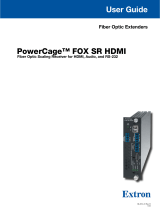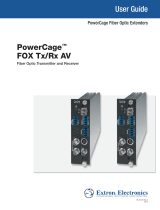Page is loading ...

PowerCage FOX SR HDMI • Setup Guide
This guide provides quick-start instructions for an experienced installer to set up and operate
the Extron PowerCage FOX SR HDMI scaling fiber optic receiver.
WARNING: Risk of serious physical injury: The receiver outputs continuous
invisible light, which may be harmful to the eyes; use with caution.
For additional safety, plug the attached dust caps into the optical
transceivers when the fiber optic cable is unplugged
Installation
Step 1 — Mounting
Install the receiver into a PowerCage enclosure as required.
NOTES: • PowerCage boards are hot-swappable.
• Ensure the boards are flush with the rear of the enclosure and
the screws are tightened securely before applying power.
Step 2 — Throughput Connections
NOTE: See the two fiber cable connection drawings below. You can connect the transmitter and one or more receivers in one of
three ways:
•
One way (transmitter to receiver) only, perform step 2a.
•
Two way (transmitter to receiver and return), perform steps 2a and 2b.
•
One way (transmitter to receiver) with daisy chain (receiver to receiver), perform steps 2a and 2c.
a. Connect the fiber between the Tx port on the transmitter and the Rx port on the receiver.
b. If you want the receiver to send return serial data (such as responses from a controlled device) to the transmitter,
connect a cable between the Tx port on the receiver and Rx port on the transmitter.
c. If you want a receiver to daisy-chain the optical signal to
another receiver (up to 10 receivers in a daisy chain):
• Connect the receiver Tx fiber cable to Rx on another receiver.
• Set each receiver to daisy chain mode (see “Return Link and
Daisy Chain Modes,” on the next page).
Tx Link and Rx Link LEDs — When lit, the link is active (light is output [Tx LED] or received [Rx LED]).
NOTE: The Link LEDs indicate transmission of light only, not whether there is data encoded in the optical link.
Step 3 — Output Connections
HDMI
a. Connect an HDMI video display to the receiver HDMI Output connector.
NOTE: Use a LockIt™ Lacing Bracket to securely fasten an HDMI cable to the receiver as
follows.
1. Plug the HDMI cable into the panel connection.
2. Loosen the HDMI connection mounting screw from the panel enough to
allow the LockIt bracket to be placed over it. The screw does not have to be
removed.
3. Place the LockIt lacing bracket on the screw and against the HDMI connector,
then tighten the screw to secure the bracket.
ATTENTION: Do not overtighten the HDMI connector mounting screw.
The shield it fastens to is very thin and can easily be stripped.
4. Loosely place the included tie wrap around the HDMI connector and the
LockIt lacing bracket as shown.
5. While holding the connector securely against the lacing bracket, use pliers or
a similar tool to tighten the tie wrap, then remove any excess length.
3
3
1
2
4
5
5A MAX.
100-240V 50/60Hz
16 available single board slots or
8 double board slots
Power
Supply
Scre
ws
Turn off or disconnect all equipment power
sources and mount the receiver as required.
Receiver
Transmitter
Tx Rx
Tx Rx
and
2a
2b
From Transmitter
or Daisy-Chained
Receiver
Receiver
Receiver
Tx Rx
Tx Rx
2a
2c

2
b. Connect a balanced or unbalanced stereo or mono audio
device to the Output Audio captive screw connector. See the
drawing at right.
ATTENTION: For unbalanced audio, connect the sleeves to the ground contact. DO NOT connect the sleeves to the negative
(–) contacts.
c. If you want the PowerCage FOX SR HDMI to pass serial data or control signals, such as for serial control of a
RS-232
OVER FIBER
Tx Rx
projector, connect the master device to the transmitter and the slave device to the receiver via the left three poles
(Tx, Rx, and
_
) of the RS-232 Over Fiber 5-pole captive screw connectors on both units.
NOTE: For RS-232 responses (from the receiver to the transmitter), you must install the Receiver-Tx-to-transmitter-Rx cable in
step 2b and leave the receiver in normal configuration (see “Return Link and Daisy Chain Modes,” below).
d. For serial control of the receiver, connect a host device, such as a computer, to the Remote RS-232
1 2
REMOTE
RS-232
Tx Rx
ALARM
port via the left poles (Tx, Rx, and
_
) of the Remote RS-232/Alarm 5-pole captive screw connector. The protocol for
these ports is as follows:
• 9600 baud • no parity • 8 data bits
• 1 stop bit • no flow control
e. For remote monitoring of the status of the Rx optical link, connect a locally
1 2
REMOTE
RS-232
Tx Rx
ALARM
constructed or obtained device to the two right Alarm poles of the Remote RS-232/Alarm 5-pole captive screw
connector. The unit shorts both poles together when no light is detected.
Step 4 — PowerCage Conguration Port
If desired, for serial control of the transmitter and receiver, connect a host device to the PowerCage enclosure Configuration
connector via the 9-pin D to 2.5 mm mini jack TRS RS-232 cable (included with the PowerCage enclosure or available separately using
part number 70-335-01). Repeatedly press the Comm Select button until the Comm LED lights for the slot where the transmitter or
receiver is installed. The protocol for this port is as follows:
• 9600 baud • no parity • 8 data bits
• 1 stop bit • no flow control
Operation
After all receivers, the transmitter, and their connected devices are powered up, the system is fully operational. If any problems are
encountered, verify that the cables are routed and connected properly and that all display devices have identical resolutions and
refresh rates. If problems persist, call the Extron S3 Sales & Technical Support Hotline at the number shown below that is closest to
you.
Return Link and Daisy Chain Modes
The receiver operates in one of two modes (or both modes can be disabled):
Return link mode — The receiver outputs data on its Tx connector for return to the transmitter.
Daisy chain mode — The receiver daisy-chains its Rx connector input through to its Tx connector output.
Issue the following SIS commands from a PC connected to the receiver Remote RS-232 port or to the PowerCage enclosure
Configuration port to toggle between return link and daisy chain modes or to disable both modes:
66*0*n#, where n = 0 = disable, 1 = enable return link (default mode), and 2 = daisy chain enable
NOTES: • Up to 10 receivers, each in daisy chain mode, can be connected in a daisy chain to a single transmitter.
• Daisy chain mode works with non-HDCP sources only.
HDMI Audio Switch
This switch mutes (Off position) and unmutes (On position) the embedded audio output on the HDMI output connector.
ON
AUDIO
OFF
The audio on the captive screw output always remains active regardless of the setting of this switch.
Signal Indications
Video LED — This LED lights when the receiver detects a signal on its video input.
HDCP
AUDIO
VIDEO
HDCP LED — This LED lights when the video signal is HDCP encrypted.
Audio LED — This LED lights when the receiver detects a low level audio signal for a short period of time.
68-2014-50 Rev. A 08 12
Extron Headquarters
+1.800.633.9876 (Inside USA/Canada Only)
Extron Europe
+31.33.453.4040
Extron Asia
+65.6383.4400
Extron Japan
+81.3.3511.7655
Extron China
+86.21.3760.1568
Extron Middle East
+971.4.2991800
Extron Korea
+82.2.3444.1571
Extron India
+91-80-3055.3777
© 2012 Extron Electronics All rights reserved. www.extron.com
Unbalanced Stereo Output
Balanced Stereo Output
Do not tin the wires!
Tip
NO GROUND HERE
NO GROUND HERE
Tip
LR
Sleeves
Tip
Ring
Tip
Ring
LR
PowerCage FOX SR HDMI • Setup Guide (Continued)
/







